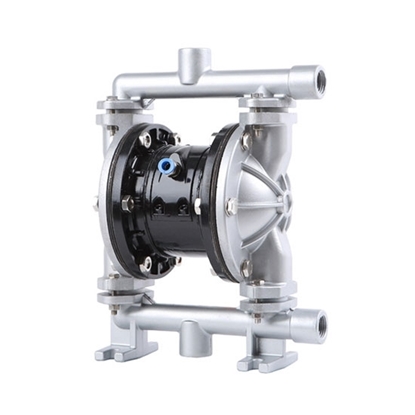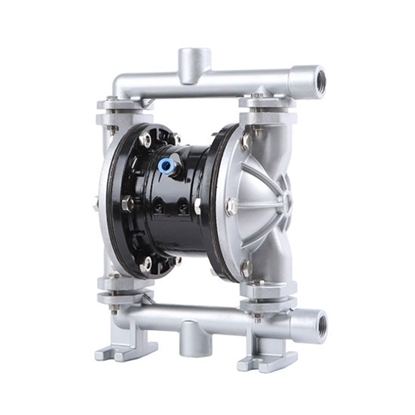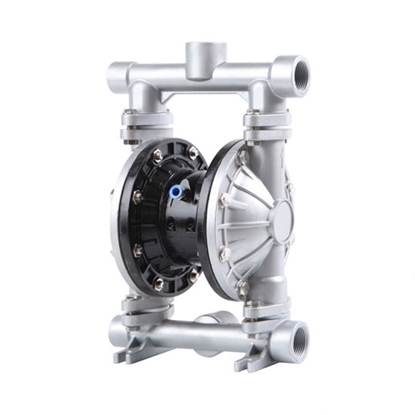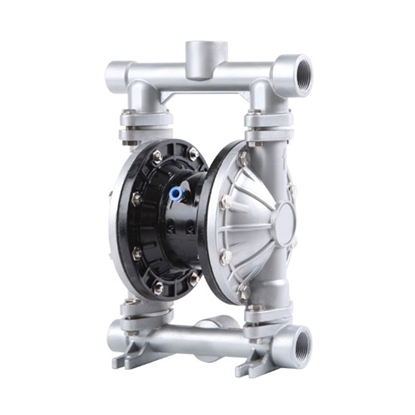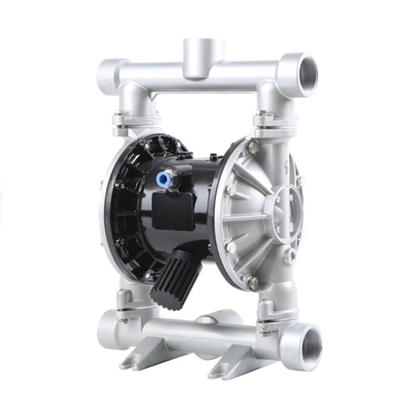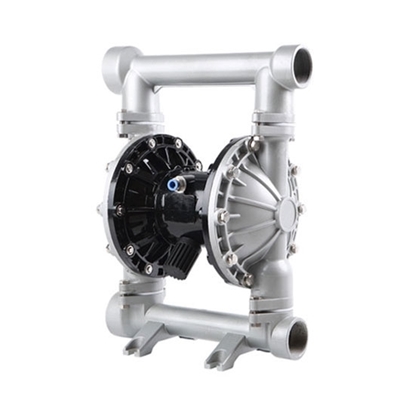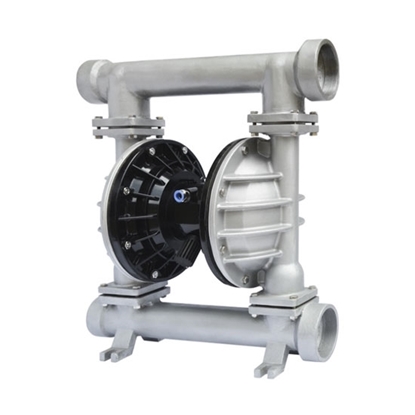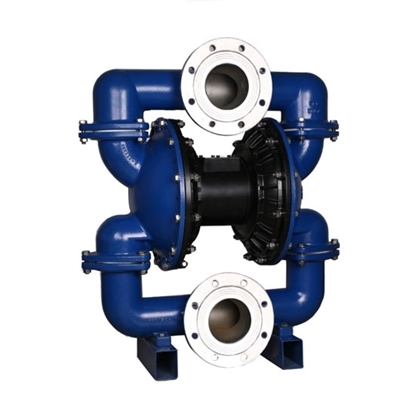Air Diaphragm Pump
3/8" Air Operated Double Diaphragm Pump, 5 GPM
1/2" Air Operated Double Diaphragm Pump, 5 GPM
3/4" Air Operated Double Diaphragm Pump, 15 GPM
1" Air Operated Double Diaphragm Pump, 15 GPM
1-1/2" Air Operated Double Diaphragm Pump, 40GPM
2" Air Operated Double Diaphragm Pump, 100 GPM
4" Air Operated Double Diaphragm Pump, 150 GPM
5" Air Operated Double Diaphragm Pump, 275 GPM
Air operated double diaphragm pump known as air powered diaphragm pump, AODD pump and AOD pump, is a pneumatic device that conveys different medias and pumps various high viscosity fluids, including lime slurry, soft sediment, sewage, crude oil and grease, etc. This air driven diaphragm pump is also used in the food industry, laboratory and chemical industry. ATO.com provides 3/8", 1/2", 3/4", 1", 1-1/2", 2", 4", 5"... fluid inlet and outlet diaphragm pumps for your choices at factory price. And these products need compressed air to work, convenient and reliable to operate.
ATO Air Operated Diaphragm Pump Features
- It will not overheat. It is a process of expansion and heat absorption when exhausting. When the pneumatic pump is working, the temperature is reduced, and no harmful gas is discharged.
- No sparks will be produced. The pneumatic diaphragm pump does not use electricity as power, and prevents static sparks after grounding.
- AODD pump can pump particle-containing liquid. Because the positive displacement works and the inlet is a ball valve, it is not easy to be blocked.
- The shear force for the material is extremely low. When working, the pump spits out as it sucks in, so the agitation of the material is minimal, and it is suitable for the transportation of unstable.
- It has the function of self-priming.
- It can do diving work.
- The fluid that can be transported is extremely wide, from low viscosity to high viscosity, from corrosive to viscous.
- Small size, light weight, easy to move.
- No lubrication is required, easy to maintain, and the working environment will not be polluted due to dripping.
- The air diaphragm pump can always maintain high efficiency and will not be reduced due to wear.
- 100% energy utilization. When the outlet is closed, the pump automatically stops.
- No dynamic seal, easy maintenance to avoid leakage.
AODD Pump Working Principle
 Diaphragm pump is a special form of positive displacement pump. It relies on the back and forth of a diaphragm to change the volume of the working chamber to suck in and discharge the liquid. The pneumatic diaphragm pump is mainly composed of the transmission part and the diaphragm cylinder head. The transmission part is a driving mechanism that drives the diaphragm to agitate back and forth. Its transmission forms include mechanical transmission, hydraulic transmission and pneumatic transmission, among which hydraulic transmission is widely used. The working part of the diaphragm pump is mainly composed of crank connecting rod mechanism, plunger, liquid cylinder, diaphragm, pump body, suction valve and discharge valve, etc. Among them, the driving mechanism composed of crankshaft connecting rod, plunger and liquid cylinder and the reciprocating column Plug pumps are very similar.
Diaphragm pump is a special form of positive displacement pump. It relies on the back and forth of a diaphragm to change the volume of the working chamber to suck in and discharge the liquid. The pneumatic diaphragm pump is mainly composed of the transmission part and the diaphragm cylinder head. The transmission part is a driving mechanism that drives the diaphragm to agitate back and forth. Its transmission forms include mechanical transmission, hydraulic transmission and pneumatic transmission, among which hydraulic transmission is widely used. The working part of the diaphragm pump is mainly composed of crank connecting rod mechanism, plunger, liquid cylinder, diaphragm, pump body, suction valve and discharge valve, etc. Among them, the driving mechanism composed of crankshaft connecting rod, plunger and liquid cylinder and the reciprocating column Plug pumps are very similar.
When the diaphragm pump is working, the crank connecting rod mechanism drives the plunger to reciprocate under the drive of the motor, and the movement of the plunger is transmitted to the diaphragm through the working liquid (usually oil) in the liquid cylinder, so that the diaphragm is agitated back and forth. The cylinder head part of the pneumatic diaphragm pump is mainly separated by a diaphragm to separate the liquid to be conveyed and the working liquid. When the diaphragm moves to one side of the transmission mechanism, the pump cylinder is under negative pressure and sucks in the liquid when the diaphragm moves to the other side. , the liquid is discharged. The liquid to be conveyed is separated from the working liquid by the diaphragm in the pump cylinder, and only contacts the pump cylinder, the suction valve, the discharge valve and the inner side of the diaphragm, but not the plunger and the sealing device. Important parts such as plugs work completely in the oil medium and are in good working condition.
The diaphragm should have good flexibility and good corrosion resistance, and it is usually made of PTFE, rubber and other materials. The pot-bottom-shaped parts with mesh holes on both sides of the diaphragm are provided to prevent excessive deformation of the diaphragm, and are generally called diaphragm limiters. The air-operated diaphragm pump has good sealing performance and can easily achieve leak-free operation. It can be used to transport corrosive liquids such as acid, alkali, salt, and high-viscosity liquids.
A diaphragm is installed in each of the two symmetrical working chambers of the pump, which are connected together by a central link. The compressed air enters the air distribution valve from the air inlet of the pump, and the compressed air is introduced into one of the chambers through the air distribution mechanism, pushing the diaphragm in the chamber to move, and the gas in the other chamber is discharged. Once the stroke end is reached, the air distribution mechanism automatically introduces compressed air into another working chamber, pushing the diaphragm to move in the opposite direction, so that the two diaphragms reciprocate continuously and synchronously. In the figure, the compressed air enters the air distribution valve, so that the diaphragm moves to the right, the suction of the chamber causes the medium to flow in from the inlet, pushes the ball valve into the chamber, and the ball valve is closed due to the suction; the medium in the chamber is squeezed, Push open the ball valve to flow out from the outlet, and at the same time lock the ball valve to prevent flow. In this way, the medium is continuously inhaled from the inlet and discharged from the outlet.
Tips for Using AODD Pump
- Ensure that the largest particle contained in the fluid does not exceed the maximum safe passing particle diameter standard of the pump.
- The intake pressure should not exceed the maximum allowable operating pressure of the pump. Compressed air higher than the rated pressure may cause personal injury, property loss and damage to the performance of the pump.
- Ensure that the pumped piping system can withstand the highest output pressure achieved, and ensure the cleanliness and normal working conditions of the driving air system.
- Static sparks may cause explosions, resulting in personal casualties and property losses. Use wires with a large enough cross-sectional area as needed to properly and reliably ground the grounding screws on the pump.
- The grounding requirements conform to local laws and regulations and some special requirements of the site.
- Tighten the pump and all connecting pipe joints to prevent static sparks caused by vibration and impact. Use antistatic hose.
- Periodically check and test the reliability of the grounding system, and the grounding resistance is required to be less than 100Ω.
- Keep good exhaust and ventilation, away from flammable, explosive and heat sources.

